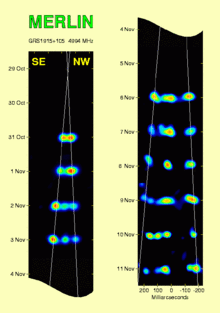- GRS 1915+105
-
GRS 1915+105 or V1487 Aquilae Observation data
Epoch J2000.0 Equinox J2000.0Constellation Aquila Right ascension 19h 15m 11.6s Declination +10° 56' 44" Distance 40.000 ly
(11.000 pc)Spectral type KIII Other designations Database references SIMBAD data GRS 1915+105 or V1487 Aquilae is an X-ray binary star system which features a regular star and a black hole. It was discovered on August 15, 1992 by the WATCH all-sky monitor aboard Granat.[1] "GRS" stands for "GRANAT source", "1915" is the right ascension (19 hours and 15 minutes) and "105" is declination in units of 0.1 degree (i.e. its declination is 10.5 degrees). The NIR counterpart was confirmed by spectroscopic observations.[2] The binary system lies 11,000 parsecs away[3] in Aquila. GRS 1915+105 is the heaviest of the stellar black holes so far known in the Milky Way Galaxy,[4] with 10 to 18 times the mass of the Sun.[5] It is also a microquasar, and it appears that the black hole may rotate at 1,150 times per second.[6]
Contents
Galactic superluminal source
In 1994 GRS 1915+105 became the first known Galactic source that ejects material with apparent faster-than-light or superluminal velocities.[7]
Observations with high resolution radio telescopes such as VLA, MERLIN and VLBI show a bi-polar outflow of charged particles, which emit synchrotron radiation at radio frequencies. These studies have shown that the apparent superluminal motion is due to a relativistic effect known as Relativistic aberration where the intrinsic velocity of ejecta is actually about 90 % the speed of light.[3]
Growth regulation
Repeat observations by the Chandra X-Ray Observatory over the period of a decade have revealed what may be a mechanism for self-regulation of the rate of growth of GRS 1915+105. The jet of materials being ejected is occasionally choked off by a hot wind blowing off the accretion disk. The wind deprives the jet of materials needed to sustain it. When the wind dies down, the jet returns.[8]
References
- ^ Castro-Tirado, A. J., Brandt, S. and Lund, N. 1992, IAUC 5590, GRS 1915
- ^ Castro-Tirado, A. J. et al. 1996, ApJ 461, L99 Infrared Spectroscopy of the Superluminal Galactic Source GRS 1915+105 during the 1994 September Outburst
- ^ a b Fender R. P., Garrington S. T., McKay D. J., Muxlow T. W. B., Pooley G. G., Spencer R. E., Stirling A. M., Waltman E. B., 1999, MNRAS, 304, 865
- ^ A Very Massive Stellar Black Hole in the Milky Way Galaxy November 28, 2001 (ESO)
- ^ GRS 1915+105
- ^ Black hole spins at the limit | COSMOS magazine
- ^ Mirabel I. F., Rodríguez L. F., 1994, Nat, 371, 46)
- ^ "An Erratic Black Hole Regulates Itself" (Press release). NASA. 2009-03-25. http://www.nasa.gov/mission_pages/chandra/multimedia/photo09-020.html. Retrieved 2009-04-16.
External links
- A Very Massive Stellar Black Hole in the Milky Way Galaxy November 28, 2001 (ESO)
- Simbad
- Image V1487 Aquilae
- O maior buraco negro estelar da Via Láctea (The biggest stellar black hole of the Milky Way) - in Portuguese.
- GRS 1915+105
- MICRO-QUASAR WITHIN OUR GALAXY
- Image The IBIS/ISGRI 20-40 keV ( width and height) image, showing the location of GRS 1915+105 and three other bright sources in the field, including the new transient IGR J19140+098 discovered during this observation. North is up and East is to the left.
- A SPI 100-200 keV image of GRS 1915+105. GRS 1915+105 is clearly visible at the center of the image (marked). The three other sources seen in Fig. 2 are much fainter in this energy range and not visible.
- The micro quasar GRS 1915+105
Categories:- X-ray binaries
- Aquila constellation
- Microquasars
- Objects named with variable star designations
Wikimedia Foundation. 2010.

